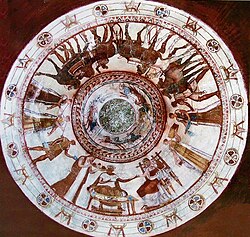The Valley of the Thracian Rulers (Bulgarian: Долина на тракийските владетели, romanized: Dolina na trakiĭskite vladeteli) is a name which was made popular by the archaeologist Georgi Kitov and describes the extremely high concentration and variety of monuments of the Thracian culture in the Kazanlak Valley in Bulgaria. It is believed that there are over 1500 tumuli in the region, with only 300 being researched so far.[1]
The Kazanlak Tomb was discovered in 1944. Between 1948 and 1954 the ancient town of Seuthopolis was studied. Between the 1960s and the 1980s people made researches of the mound necropolis which belonged to residents of Sevtopolis. Another two brick tombs were found there. The Maglizh and Kran tombs were discovered in 1965. The 60s also marked the research of Thracian tombs from the Roman era in the regions of the villages of Tulovo and Dabovo, made by Prof. L. Getov. During the 70s M. Domaradski, Ph. D., researched a habitation and its surrounding necropolis in the Atanastsa region, village of Tazha.
The period between 1992 and 2006, with short interruptions, marked the research made by Senior Research associate G. Kitov, Ph. D., and the expedition TEMR (Thracian Expedition for Mound Research) led by him. As a result of their activity over 200 mounds, which represent funeral practices of the Thracians during the Iron and Roman Eras in the Kazanlak Valley, were studied. Among all the monuments one can distinguish over 15 tombs in a different stage of preservation, 3 masonry graves, a lot of rich funerals, etc.
In recent years, work by archaeologists has been going on successfully with the research of tombs near the villages of Dolno Izvorovo and Buzovgrad.

- ^ "Explore the Valley of Thracian Kings - Bulgaria's Thracian Heritage". 15 February 2019.